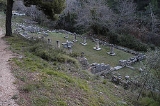
Amphiareion of Oropos
Encyclopedia
The Amphiareion of Oropos (Greek: Άμφιαρείον Ωρωπού), situated in the hills 6 km southeast of the fortified port of Oropos
, was a sanctuary dedicated in the late 5th century BCE to the hero Amphiaraos
, where pilgrims went to seek oracular responses and healing. It became particularly successful during the 4th century BCE, to judge from the intensive building at the site. The hero Amphiaraos was a descendant of the seer Melampos
and initially refused to participate in the attack on Thebes
(detailed in the Seven Against Thebes
of Aeschylus
) because he could foresee that it would be a disaster. In some versions of the myth, the earth opens and swallows the chariot of Amphiaraos, transforming him into a chthonic
hero.
The sanctuary is located 37.2 km NNE of Athens at a sacred spring; it contained a temple of Amphiaraos (with an acrolith
ic cult statue
), as well as a theater, a stoa
, and associated structures. The temenos
extended for some 240 metres northeast from the Temple of Amphiaraos (hence Amphiareion) along a streambed. The cult, which was both public and private, dates to the 5th century BCE. There was an upswing in the sanctuary’s reputation as a healing site during the plague that hit Athens in the late 5th BCE Herodotus
relates that the oracular response of this shrine was one of only two correct answers to the test put to them all by the Lydian king Croesus
. There were many dedications from Greeks, notable Romans, and others, many with inscriptions. On the southeast side of the streambed there are extensive remains of domestic structures as well as an unusually well-preserved klepsedra (water clock).
At the Amphiareion, in addition to the presumed annual festival, Greater Amphiareia were celebrated in an agonistic festival of athletic games, every fifth year. Two reliefs of the late 5th-early 4th century BCE seem to provide the earliest attestations of the festival games; there is an inscribed catalogue of victors at the Greater Amphiareia that dates before 338 BCE.
Amphiaraos was also worshiped at the site of Rhamnous
about 17.5 km southeast, as well as at Athens, Argos, Sparta, and other sites. The cult at the Amphiareion came to an end with the outlawing of non-Christian worship in the Theodosian decrees at the end of the 4th century CE.
In 414 BCE Aristophanes
produced a comedy, Amphiaraos, of which fragments survive as quotations.
 At the Temple of Amphiaraos, the site is about 154 m in elevation, with a gentle slope to the northeast, as it fills the northwest bank of a small ravine between two hills. The sanctuary was located near the border of Attica and Boiotia, the respective spheres of control of Athens and Thebes; control over the site passed back and forth between the rival cities until Alexander the Great destroyed Thebes in 335 BCE. In the 2nd century CE, the Greek periegetic writer Pausanias
At the Temple of Amphiaraos, the site is about 154 m in elevation, with a gentle slope to the northeast, as it fills the northwest bank of a small ravine between two hills. The sanctuary was located near the border of Attica and Boiotia, the respective spheres of control of Athens and Thebes; control over the site passed back and forth between the rival cities until Alexander the Great destroyed Thebes in 335 BCE. In the 2nd century CE, the Greek periegetic writer Pausanias
stated:
An inscription from the site, however, states that each man may sacrifice what he wants. Some variation in practice during the nine centuries of cult activity at the sanctuary may be expected. The baths of the site were famous in antiquity. The locations of a stadion and a hippodrome
are unknown.
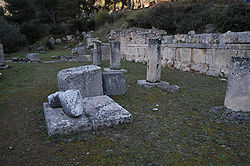 The early 4th century BCE temple of Amphiaraos was of an unusual Doric
The early 4th century BCE temple of Amphiaraos was of an unusual Doric
hexastyle in antis plan: i.e. it has six columns across the front façade between small projecting walls. The antae were capped with half columns, giving the appearance of an octostyle façade. It measures 14 by 28 m. Behind the columns was a pronaos, leading into a cella
with two rows of five un-fluted internal columns. Alongside the second pair of columns back from the pronaos there was a base for the acrolithic cult statue of Amphiaraos of which one arm remains in situ. In the rear wall of the cella, there was a threshold, perhaps a later addition.
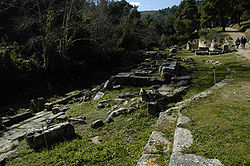 On axis with the center line of the temple, and about 10.5 m northeast, are the remains of the altar divided into sections with inscriptions to a number of gods and heroes. Pausanias (1.34.3) says that the altar was dedicated to five groups:
On axis with the center line of the temple, and about 10.5 m northeast, are the remains of the altar divided into sections with inscriptions to a number of gods and heroes. Pausanias (1.34.3) says that the altar was dedicated to five groups:
Wrapping around the altar on the west side is a stepped structure that may have served as an early theatral area before the construction of the theater. Immediately to the east is the sacred spring, where Pausanias says worshipers threw coins when they were healed of a disease. Immediately northeast of the spring is the structure traditionally called the men’s bath.
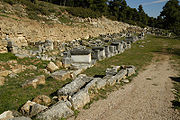 To the northeast of the temple was a line of dedications of statuary, of which the bases (illustration, right) have largely survived; the avenue stretched for around 70 m along the road into the sanctuary. Among the more notable dedications, all of the Roman era:
To the northeast of the temple was a line of dedications of statuary, of which the bases (illustration, right) have largely survived; the avenue stretched for around 70 m along the road into the sanctuary. Among the more notable dedications, all of the Roman era:
There are also the remains of a small temple at the southwest extremity of this area.
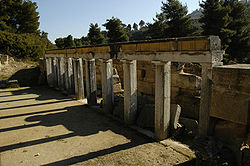 The theater is dated to the 2nd century BCE by inscriptions and the seating area was likely composed of wooden seats on stone supports. Five marble prohedria (seat of honor at the front of the seating area) were discovered placed around the orchestra, which had a radius of 12.4 m. Two parodoi
The theater is dated to the 2nd century BCE by inscriptions and the seating area was likely composed of wooden seats on stone supports. Five marble prohedria (seat of honor at the front of the seating area) were discovered placed around the orchestra, which had a radius of 12.4 m. Two parodoi
(side entryways) led off from the orchestra between the seating area of the cavea
and the stage building. The Doric order proscaenium of the stage structure (c. 12 m wide) is well preserved and thus important for the study of theater design. The theater would have held approximately three hundred spectators.
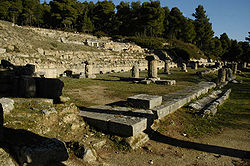 Dating to the mid-4th century BCE, the stoa measured 11 by 110 m with 39 exterior Doric columns and 17 internal Ionic columns. There were stone benches set into the back walls of the structure, perhaps where the suppliants of the god slept and awaited their dreams. The sexes may have been segregated as may have been the case for the bath to the northeast of the stoa, which is traditionally called the women’s bath.
Dating to the mid-4th century BCE, the stoa measured 11 by 110 m with 39 exterior Doric columns and 17 internal Ionic columns. There were stone benches set into the back walls of the structure, perhaps where the suppliants of the god slept and awaited their dreams. The sexes may have been segregated as may have been the case for the bath to the northeast of the stoa, which is traditionally called the women’s bath.
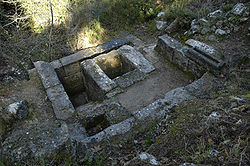 On the southeast side of the streambed opposite the sacred spring are the remains of an unusually well-preserved klepsedra (water clock). This instrument is important in the study of ancient methods of timekeeping in that it is an example of an inflow water clock. Since an inflow clock measures time by the filling of a known volume from a constant rate of inflow, it is much more accurate than an outflow water clock in measuring the gradations between full and empty. The klepsedra was composed of a central, square reservoir with a steep stairway on the south side to allow access to the bronze plug at the bottom of the reservoir. Domestic structures for the operation of the sanctuary are closely packed along the southeast side of the ravine, both north and south of the klepsedra.
On the southeast side of the streambed opposite the sacred spring are the remains of an unusually well-preserved klepsedra (water clock). This instrument is important in the study of ancient methods of timekeeping in that it is an example of an inflow water clock. Since an inflow clock measures time by the filling of a known volume from a constant rate of inflow, it is much more accurate than an outflow water clock in measuring the gradations between full and empty. The klepsedra was composed of a central, square reservoir with a steep stairway on the south side to allow access to the bronze plug at the bottom of the reservoir. Domestic structures for the operation of the sanctuary are closely packed along the southeast side of the ravine, both north and south of the klepsedra.
Oropos
Oropos is a small town and a municipality in East Attica, Greece.-Geography:It is situated on the southern Euboean Gulf, opposite Eretria. Oropos is located N of Avlona and Athens, E of Thebes and SE of Chalcis. Oropos is linked with the road linking Nea Palatia and Sikamino...
, was a sanctuary dedicated in the late 5th century BCE to the hero Amphiaraos
Amphiaraus
In Greek mythology, Amphiaraus was the son of Oecles and Hypermnestra, and husband of Eriphyle. Amphiaraus was the King of Argos along with Adrastus— the brother of Amphiaraus' wife, Eriphyle— and Iphis. Amphiaraus was a seer, and greatly honored in his time...
, where pilgrims went to seek oracular responses and healing. It became particularly successful during the 4th century BCE, to judge from the intensive building at the site. The hero Amphiaraos was a descendant of the seer Melampos
Melampus
In Greek mythology, Melampus, or Melampous , was a legendary soothsayer and healer, originally of Pylos, who ruled at Argos. He was the introducer of the worship of Dionysus, according to Herodotus, who asserted that his powers as a seer were derived from the Egyptians and that he could understand...
and initially refused to participate in the attack on Thebes
Thebes, Greece
Thebes is a city in Greece, situated to the north of the Cithaeron range, which divides Boeotia from Attica, and on the southern edge of the Boeotian plain. It played an important role in Greek myth, as the site of the stories of Cadmus, Oedipus, Dionysus and others...
(detailed in the Seven Against Thebes
Seven Against Thebes
The Seven against Thebes is the third play in an Oedipus-themed trilogy produced by Aeschylus in 467 BC. The trilogy is sometimes referred to as the Oedipodea. It concerns the battle between an Argive army led by Polynices and the army of Thebes led by Eteocles and his supporters. The trilogy won...
of Aeschylus
Aeschylus
Aeschylus was the first of the three ancient Greek tragedians whose work has survived, the others being Sophocles and Euripides, and is often described as the father of tragedy. His name derives from the Greek word aiskhos , meaning "shame"...
) because he could foresee that it would be a disaster. In some versions of the myth, the earth opens and swallows the chariot of Amphiaraos, transforming him into a chthonic
Chthonic
Chthonic designates, or pertains to, deities or spirits of the underworld, especially in relation to Greek religion. The Greek word khthon is one of several for "earth"; it typically refers to the interior of the soil, rather than the living surface of the land or the land as territory...
hero.
The sanctuary is located 37.2 km NNE of Athens at a sacred spring; it contained a temple of Amphiaraos (with an acrolith
Acrolith
An acrolith was a statue made in Classical antiquity, in which the trunk of the figure was made of wood, and the head, hands, and feet were made of marble...
ic cult statue
Cult image
In the practice of religion, a cult image is a human-made object that is venerated for the deity, spirit or daemon that it embodies or represents...
), as well as a theater, a stoa
Stoa
Stoa in Ancient Greek architecture; covered walkways or porticos, commonly for public usage. Early stoae were open at the entrance with columns, usually of the Doric order, lining the side of the building; they created a safe, enveloping, protective atmosphere.Later examples were built as two...
, and associated structures. The temenos
Temenos
Temenos is a piece of land cut off and assigned as an official domain, especially to kings and chiefs, or a piece of land marked off from common uses and dedicated to a god, a sanctuary, holy grove or holy precinct: The Pythian race-course is called a temenos, the sacred valley of the Nile is the ...
extended for some 240 metres northeast from the Temple of Amphiaraos (hence Amphiareion) along a streambed. The cult, which was both public and private, dates to the 5th century BCE. There was an upswing in the sanctuary’s reputation as a healing site during the plague that hit Athens in the late 5th BCE Herodotus
Herodotus
Herodotus was an ancient Greek historian who was born in Halicarnassus, Caria and lived in the 5th century BC . He has been called the "Father of History", and was the first historian known to collect his materials systematically, test their accuracy to a certain extent and arrange them in a...
relates that the oracular response of this shrine was one of only two correct answers to the test put to them all by the Lydian king Croesus
Croesus
Croesus was the king of Lydia from 560 to 547 BC until his defeat by the Persians. The fall of Croesus made a profound impact on the Hellenes, providing a fixed point in their calendar. "By the fifth century at least," J.A.S...
. There were many dedications from Greeks, notable Romans, and others, many with inscriptions. On the southeast side of the streambed there are extensive remains of domestic structures as well as an unusually well-preserved klepsedra (water clock).
At the Amphiareion, in addition to the presumed annual festival, Greater Amphiareia were celebrated in an agonistic festival of athletic games, every fifth year. Two reliefs of the late 5th-early 4th century BCE seem to provide the earliest attestations of the festival games; there is an inscribed catalogue of victors at the Greater Amphiareia that dates before 338 BCE.
Amphiaraos was also worshiped at the site of Rhamnous
Rhamnous
The site of Rhamnous , the remote northernmost deme of Attica, lies 39 km NE of Athens and 12.4 km NNE of Marathon, Greece overlooking the Euboean Strait. Rhamnous was strategically significant enough to be fortified and receive an Athenian garrison of ephebes...
about 17.5 km southeast, as well as at Athens, Argos, Sparta, and other sites. The cult at the Amphiareion came to an end with the outlawing of non-Christian worship in the Theodosian decrees at the end of the 4th century CE.
In 414 BCE Aristophanes
Aristophanes
Aristophanes , son of Philippus, of the deme Cydathenaus, was a comic playwright of ancient Athens. Eleven of his forty plays survive virtually complete...
produced a comedy, Amphiaraos, of which fragments survive as quotations.
Sanctuary of Amphiaraos

Pausanias (geographer)
Pausanias was a Greek traveler and geographer of the 2nd century AD, who lived in the times of Hadrian, Antoninus Pius and Marcus Aurelius. He is famous for his Description of Greece , a lengthy work that describes ancient Greece from firsthand observations, and is a crucial link between classical...
stated:
I think that Amphiaraos most of all dedicated himself to interpreting dreams: it is clear that, when he was considered a god, he set up an oracle of dreams. And the first thing is to purify oneself, when someone comes to consult Amphiaraos, and the purification ritual is to sacrifice to the god, and people sacrifice to him and to all those whose names are on (the altar), and - when these things are finished – they sacrifice a ram and spread out its skin under themselves, lie down waiting for the revelation of a dream.
Description of Greece 1.34.5
An inscription from the site, however, states that each man may sacrifice what he wants. Some variation in practice during the nine centuries of cult activity at the sanctuary may be expected. The baths of the site were famous in antiquity. The locations of a stadion and a hippodrome
Hippodrome
A hippodrome was a Greek stadium for horse racing and chariot racing. The name is derived from the Greek words "hippos and "dromos"...
are unknown.
Temple of Amphiaraos

Doric order
The Doric order was one of the three orders or organizational systems of ancient Greek or classical architecture; the other two canonical orders were the Ionic and the Corinthian.-History:...
hexastyle in antis plan: i.e. it has six columns across the front façade between small projecting walls. The antae were capped with half columns, giving the appearance of an octostyle façade. It measures 14 by 28 m. Behind the columns was a pronaos, leading into a cella
Cella
A cella or naos , is the inner chamber of a temple in classical architecture, or a shop facing the street in domestic Roman architecture...
with two rows of five un-fluted internal columns. Alongside the second pair of columns back from the pronaos there was a base for the acrolithic cult statue of Amphiaraos of which one arm remains in situ. In the rear wall of the cella, there was a threshold, perhaps a later addition.

- Heracles, Zeus and Apollo the Healer (Παιών)
- Heroes and heroes’ wives
- Hestia, Hermes, Amphiaraos, and of the children of Amphiaros, Amphilochos
- Aphrodite, Panacea ("all-cure"), Iaso, Hygeia, and Athena the Healer (Παιωνία)
- Nymphs and Pan; the rivers Achelous and Cephisus.
Wrapping around the altar on the west side is a stepped structure that may have served as an early theatral area before the construction of the theater. Immediately to the east is the sacred spring, where Pausanias says worshipers threw coins when they were healed of a disease. Immediately northeast of the spring is the structure traditionally called the men’s bath.

- 42 BCE inscription honoring Marcus Junius BrutusMarcus Junius BrutusMarcus Junius Brutus , often referred to as Brutus, was a politician of the late Roman Republic. After being adopted by his uncle he used the name Quintus Servilius Caepio Brutus, but eventually returned to using his original name...
as a Tyrannicide - 86-81 BCE inscription for the Roman dictator Lucius Cornelius SullaLucius Cornelius SullaLucius Cornelius Sulla Felix , known commonly as Sulla, was a Roman general and statesman. He had the rare distinction of holding the office of consul twice, as well as that of dictator...
- post 27 BCE inscription for Marcus Agrippa
- 1st BCE inscription for Appius Claudius Pulcher
- inscription for Gnaius Calpurnius Piso.
There are also the remains of a small temple at the southwest extremity of this area.
Theater

Parodos
Parodos is a term used in Ancient Greek comedy and tragedy. A parodos is both the first entrance of the chorus into the orchestra and the choral ode that they sing and dance as they enter...
(side entryways) led off from the orchestra between the seating area of the cavea
Cavea
In Roman times the cavea were the subterranean cells in which wild animals were confined before the combats in the Roman arena or amphitheatre....
and the stage building. The Doric order proscaenium of the stage structure (c. 12 m wide) is well preserved and thus important for the study of theater design. The theater would have held approximately three hundred spectators.
Stoa

Klepsedra


